*Teams from Ireland, Taiwan, France, Poland, Brazil, Greece, Korea, Denmark and Romania today took home the nine top awards at Microsoft’s 9th annual Imagine Cup. Microsoft also announced a $3 million grant program to help Imagine Cup participants solve the world’s toughest challenges.*
NEW YORK CITY – July 13, 2011 – Student projects that tackle global problems such as improving road and fire safety, eradicating poverty, and creating a more sustainable environment took top honors at the Imagine Cup 2011 Worldwide Finals in New York on Wednesday.
Ireland’s Team Hermes won the competition’s premier Software Design category and $25,000 (U.S.) with their project that combined embedded technology, mobile devices and cloud computing technology to change driving habits and reduce road deaths.
“Thank you Imagine Cup for the opportunity to develop a solution to address this global, serious problem of road traffic accidents,” said team member Aine Conaghan as they collected the Imagine Cup trophy. “Initially we were inspired due to the fact of this problem in Ireland. The more research we carried out, we realized ‘yeah, we’re going to make an impact globally.’”
The members of Team Hermes said traffic accidents are a huge problem in Sligo, the northwestern Irish city where they go to school. “Initially we wanted to do something to improve road safety,” said team member Calum Cawley. “So many people are dying we had to do something about it.”
About the video: Student teams from around the world competed in nine categories and Team Hermes from Sligo Institute of Technology in Ireland took top honors in the Software Design category. Over 350,000 students globally took part in the competition over the past months, leading to the Worldwide Finals in New York City July 8-13. Credit: Microsoft
The team developed a smart device that can plug into any car made after 2000, Conaghan said. It uploads driving information to the cloud and gives the driver a report on their behavior. “Research has shown that educating the drivers reduces fatalities on the roads,” she said.
The team used a number of Microsoft technologies to create their project including Silverlight, Azure, and SQL Server. “It’s all compatible,” said James McNamara, also a team member. “It’s a great system to work in.”
Looking ahead, Team Hermes wants to get their project out into the world to make an impact on roads worldwide. “We want to develop a sustainable project that not only saves lives but generates enough income to bring the product forward and establish a mass user group and a mass community, because the more users we have the more lives we can save,” McNamara said.

Team Hermes. Ireland’s Team Hermes won this year’s Software Design competition with a project that combined embedded technology, mobile devices and cloud computing technology to change driving habits and reduce road deaths. Image Credit: Microsoft
Taiwan’s Team NTHUCS won the Embedded Development contest and $25,000 with their project RIGHT!! This Way, which computes the safest fire escape routes in real time as detected by a wireless sensor network, while the three winners from the Game Design category all focused on some aspect of environmental sustainability.
The winners were announced tonight at the Imagine Cup World Festival and Awards Ceremony at the David H. Koch Theater at Lincoln Center in New York. The event capped a six-day celebration of technology that featured more than 400 students from 70 countries.
During the ceremony, Microsoft also unveiled plans to launch a three-year, $3 million competitive grant program to help recipients realize their vision of solving the world’s toughest problems.
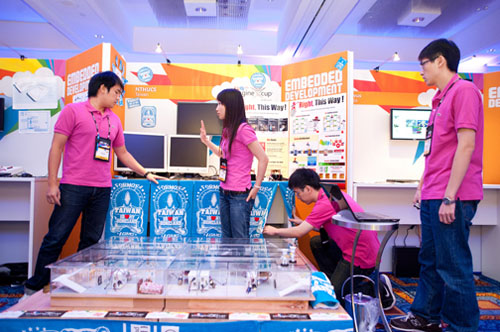
NTHUCS. Taiwan’s Team NTHUCS sets up their display booth at the Imagine Cup 2011 Worldwide Finals. The team won the Embedded Development contest with project RIGHT!! This Way, which computes the safest fire escape routes in real time as detected by a wireless sensor network. Image Credit: Microsoft
“The innovators, entrepreneurs and humanitarians who compete in the Imagine Cup have developed an inspiring spectrum of projects, raising the bar higher and higher each year,” said S. Somasegar, senior vice president, Developer Division, Microsoft. “We are in awe of the students’ solutions for addressing social and real-world challenges, and want to help them take their projects to the next level with the financial, technical and business support they need to change the world.”
Imagine Cup finalists will be eligible to apply for grants that include a combination of cash, software, training, consulting and other support. Microsoft will announce details about the grant program and application process later this summer.
At the awards ceremony, New York City Mayor Mike Bloomberg and activist and actress Eva Longoria also expressed their awe of the students’ tech skills and passion to change the world.
Longoria told the students she was honored to support and shine a light on the finalists’ work, which she had a chance to review earlier in the day. She called out specific teams like Thailand’s NewKrean, who responded to a devastating flood in their country with a project that will help rescue workers find victims after a disaster. Before leaving the stage, Longoria told the students they were the next generation of leaders who were going to give us all a better future.
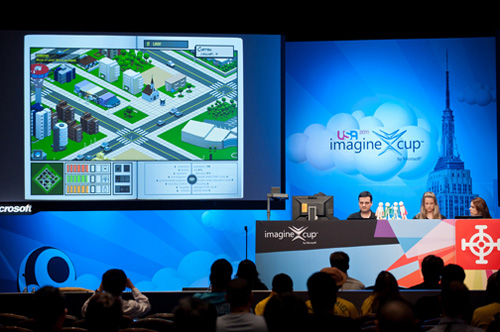
Signum Games. Brazil’s Team Signum Games demos their winning Game Design – Windows/Xbox entry "UCan," a strategy game that invites players to solve urban problems involving health, education and the environment. Image Credit: Microsoft
She then announced the winner of the People’s Choice Award, Bangladesh’s Team Rapture, whose project, ThirdEye, is a smartphone device for the visually impaired.
Earlier, Bloomberg encouraged the students to work together as they tackle the world’s toughest problems, just like the diverse residents of New York City do. It will take collaboration to eliminate poverty and illness, combat global warming, and preserve the environment, he said. He then held up his friends Bill and Melinda Gates as two people who were truly changing the world and challenged the finalists to follow in their footsteps. He closed with an invitation for all the students to make New York City their future home.
Winners bounded onto the stage, waved flags, and pumped their fists. One member of Brazil’s Signum Games team that won the Windows/Xbox category of Game Design shouted at the crowd, “If we can, you can!” As France’s Geekologic collected its award in the Game Design – Mobile category, a team member thanked the crowd and urged them “to continue this work and we will really make this world a better place.”
All the winners in the Game Design category focused on some element of environmental sustainability. In Game Design — Mobile, Team Geekologic, from France, focused on renewable energy. In Game Design — Web, Poland’s Team Cellardoor created the “Book of Elm,” which encourages players to take care of the environment. And in Game Design — Windows/Xbox, Team Signum Games, from Brazil, solved urban problems involving health, education and the environment, through a strategy game. Each first-place team earned $25,000.
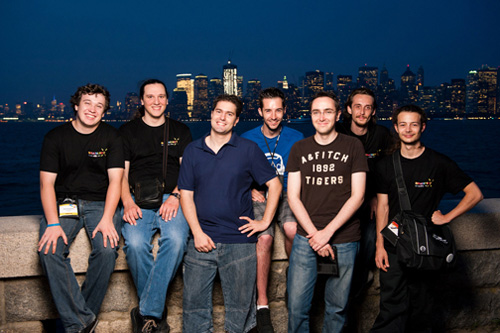
Geeklogic. Team Geeklogic from France won the Game Design – Mobile contest with "Brainergy," a Windows Phone 7 puzzle game in which the player has to solve different challenges based on renewable energy. Image Credit: Microsoft
Team Signum’s Fernanda Fonteles said she was amazed her team came out on top. “It’s unbelievable,” she said. “We saw the other projects – they are very strong.” The team’s game was inspired by volunteers who helped clean up their home city of Curitiba, Brazil. “It’s very important to bring the top prize to our university,” Fonteles said.
In the Windows Phone 7 category, Korea’s Team HOMERUN took first place with Peekaboo, an application designed to help family members communicate with each other through a treasure-hunt game. Greece’s Team Alaniarides won the Interoperability Challenge with their Touring Machine, which offers adults and children a new kind of cultural experience, and Romania’s Team M.N.A. won the Digital Media category. France’s Jean-Sébastien Duchene won the IT Challenge.
Starting companies to save the world
When the finals kicked off last Friday, economist Jeffrey Sachs gave the students a homework assignment: saving the world. “You don’t just leave here with the Imagine Cup and think your work is done – you have a lot of work ahead,” he said.
Many of the participants hope to meet that challenge by forming their own companies. Dennis Anderson, a professor of management and information technology at St. Francis College in New York and longtime advisor to the Imagine Cup, said that the event serves as a launching pad for many students.
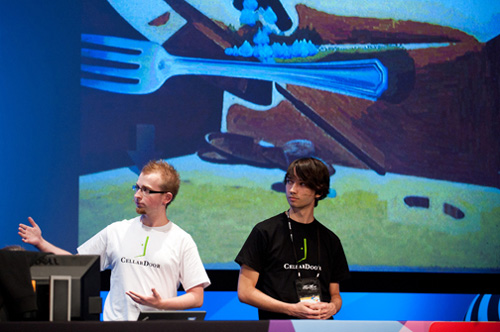
Cellardoor. Members of Poland’s Team Cellardoor demo "The Book of Elm" for the judges. The game, which won the Game Design – Web category, illustrates the importance of taking care of the environment in everyday life through the interactive story of Elm, a creature on a quest to fix the mistakes done by people around the world. Image Credit: Microsoft
“(The Imagine Cup) opens up career pathways for many of the finalists,” said Anderson, who also served as one of the judges in this year’s Software Design category. “This is definitely more than a competition. They are working very hard to start new businesses.”
Students aren’t merely seeing dollar signs with plans to form their own companies, said Mark Hindsbo, vice president of Microsoft’s Developer and Platform Evangelism Group in the U.S. “I haven’t heard one of the teams say they want to make money,” he said. “They want to make a difference in the world.”
One of them is the United States’ Team LifeLens, which finished third in the competition’s Windows Phone 7 category. The team – a multidisciplinary group made up of business, medicine, computer science and marketing students – hopes to deploy their project in the real world to save lives.
Using their software, Team LifeLens wants to not only test blood in the field but also do analysis and diagnosis, said team member Wilson To. The resulting data stream can then be fed into a model the students are building that will show medical experts where a malaria outbreak is occurring in real time, allowing them to come up with better strategies for managing outbreaks. That will help experts deploy what are very limited resources in the best way possible, he said.
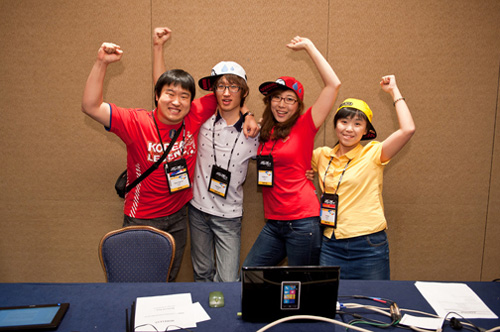
HOMERUN. In the Windows Phone 7 category, Korea’s Team HOMERUN took first place with Peekaboo, an application designed to help family members communicate with each other through a treasure-hunt game. Image Credit: Microsoft
The students have been meeting with venture capital firms to secure funding and hope to start deploying their solution in South Africa and India. They have created a technical model using data pulled from medical centers and now want to build a full prototype.
In the beginning stages of forming a business, LifeLens also has been discussing ways to collaborate with other teams at the Imagine Cup, including New Zealand’s Team OneBuzz. OneBuzz is working to combat the spread of malaria through effective information management. Their project focuses on tackling malaria with sophisticated technology that identifies areas of high risk and provides real-time information to those concerned so they can act accordingly.
The Kiwis know a thing or two about success after the Imagine Cup. Two members from OneBuzz participated in last year’s competition, where they finished third in the Software Design category. Their project, called OneBeep, transmits educational data over radio waves to impoverished communities.
Vinny Lohan said that after last year’s Imagine Cup, he and his OneBeep teammates formed their own company to license the technology. Since then they’ve attracted the attention of Icehouse, one of the top 10 incubation firms in the world, which is providing the young company with funding and support. Today they are conducting field tests in South America, and Lohan, the company’s CEO, said they’re six months from global deployment.
He credited the Imagine Cup and Microsoft’s BizSpark program with getting their company off the ground.
“(The Imagine Cup) is the beginning, not the end of the journey,” he said. “The Imagine Cup turns students into entrepreneurs.”
In New York City, it appeared many students were already on their way. Take Kevin Pfister, a one-man team called Cycling Into Trees who represented the U.K. in the Embedded Development category. His Child Sleep Safe project uses a mixture of embedded hardware, software and home automation systems to reduce crib death numbers by monitoring babies while sleeping. “It represents the next generation of baby monitoring,” he said.
He’s already built a working prototype of Child Sleep Safe and presented it to Mothercare, the U.K.’s largest specialist retailer for parents. “They gave us a good response,” Pfister said. “I’m going to move ahead with it.”
Before Wednesday’s award ceremony, Lohan had said that winning this year’s Software Design category would be nice, but it isn’t everything. “For me personally, the Imagine Cup is all about empowerment,” he said. He was inspired to hear Foursquare founder Dennis Crowley share his journey at Friday’s opening ceremonies. “He did it, so why can’t we?” Lohan said.
Lohan seems to be well on his way to answering that question. He is CEO of the company OneBeep, which has six employees, and the company plans to add the members of the OneBuzz team after the Imagine Cup is over so they can help pursue the malaria solution.
In the meantime, though, he was going to have fun in New York: “We won’t be students next year, so why not go out with a bang?”
Thirty-five million fans cheering for the ‘next technical idol’
By any yardstick – the number of students competing or the number of countries represented – the Imagine Cup 2011 was the biggest event yet, Microsoft’s Hindsbo said. But there’s still plenty of room to get more people to support the student competitors.
Hindsbo pointed out that 30,000 people will show up and cheer on a high school football team, and some 55 million root for the next American Idol. “How do we get the same number of people cheering for the next technical idol?” he said. “We need the same amount of cheering and passion.”
He said that will drive interest in the field, and help lead students to go into science, technology engineering fields (known as STEM), where there is projected to be a major shortfall of job candidates in the coming years.
Looking forward, the Imagine Cup will focus on building that level of support for students going into STEM fields. “Let’s go from 350,000 competitors to 35 million people cheering,” he said.
Hindsbo said technology itself can be used to showcase the competition. Why not have high school and grade school students from New Zealand follow the progress of the team competing in the world finals from their home country, he asked. “If we could get 10 and 12 year olds watching, what better way to inspire them,” he said.
Inspiring more students to enter technical fields will be a critical issue for the U.S. as it competes with countries such as China and India, Hindsbo said.
“We need the next Microsoft, the next Facebook, the next Foursquare,” he said. “The U.S. has been such an innovator in business and technology, and if we’re going to continue to do that, we need the chain of innovation to continue to develop new services, new products, and to have new breakthroughs. If the U.S. doesn’t have it, there’s no doubt that it will slow down.”
Encouraging more women to enter science, technology, engineering and math fields could help fill the shortage of viable candidates in the tech sector, and bring a new wave of ideas and perspectives along the way, Hindsbo said.
Sixty women participated in the Imagine Cup Finals, double last’s year numbers. Those students could help inspire more women to take an interest in tech.
“We need those women to be an inspiration to girls early on when they are making decisions on their careers,” he said.
Allison Watson, corporate vice president of the U.S. Marketing and Operations group at Microsoft, hopes the Imagine Cup continues to get more women to attend. On Sunday Watson led a panel discussion where she invited women competitors to talk about the issues and challenges surrounding getting more women into STEM fields and to inspire them to be role models for others.
“(We need) to bring the voice and stories of the women competitors to others,” she said. “The more women you can get here, the more you can create a community of people who can support each other.”
Role models can make a huge difference in getting more women interested in technology careers, which can be intimidating, she said.
“Let’s demystify what this thing is,” she said.
Elsa Friscira, a female member of Switzerland’s Texting4All who attended Watson’s panel discussion, knows how daunting it can be to enter a male-dominated field. In her program of 300 students, there are at most 10-20 women. “It’s really difficult,” she said. “The guys think you are stupid because you haven’t been passionate about computer science since you were 6 years old.”
She said it was really hard to integrate.
Attending the Imagine Cup and listening to a panel of women with similar challenges and problems was inspiring for her. “I was very happy,” she said. “All of these efforts are being rewarded.” She said attending the Imagine Cup has her thinking about getting a Ph.D., which she hadn’t been planning to persue because of how hard it’s been.
Watson heard similar tales from other female participants. “It’s amazing the inspiration you can get from other people’s stories,” she said.
Watson said she’s optimistic that more women will be drawn to high-tech careers as technology, and mobile technology in particular, becomes much more accessible. “Women are the earliest adopters of mobile phone technology,” she said, “which makes that platform less intimidating to women developers, and which could make it a good platform to bring in more women.”
She added that the Imagine Cup is a great platform for female students, noting that even the Imagine Cup name is approachable: “We want people to dream.”
*Source: Microsoft
